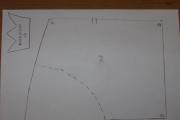How to place an obstetric pessary. There are cases when early removal of pessaries is required.
One of the causes of miscarriage is isthmic-cervical insufficiency or cervical incompetence. This pathology can be of anatomical or functional origin.
An alternative to surgical treatment of isthmic-cervical insufficiency during gestation is the installation of an obstetric pessary. This device is made of flexible plastic or silicone, treated with gamma rays (ensuring sterility) and is a concave pyramid of several interconnected rings with smooth and semicircular edges.
The wide base of the pessary is directed towards the rectum, and the narrower one towards the pubic symphysis. Due to the concave shape of the bases, the rectum and bladder are unloaded and are not compressed. In the center of the device there is a hole intended for the cervix, which is shifted towards a wide base. On the sides of the central hole there are holes with a smaller diameter, necessary for the outflow of vaginal secretions. The jumpers located between the holes maintain the rigidity and strength of the device.
Mechanism of action of the pessary
The action of the obstetric pessary is carried out due to the following points:
- reducing the load on the incompetent cervix by shifting the pressure of the embryo;
- redistribution of pressure inside the uterus;
- the cervix is closed by the walls of the central opening;
- the mucous plug in the cervix is preserved, reducing the risk of infection of it, the membranes and the fetus.
Indications for installation
A pessary during pregnancy is installed in the following cases:
- isthmic-cervical insufficiency (both functional and organic);
- prevention of suture dehiscence on the cervix after surgical treatment of cervical incompetence;
- multiple pregnancy (high risk of premature birth);
- high risk of isthmic-cervical insufficiency.

Photo: Madhero88 at ru.wikipedia.org
Contraindications
An obstetric pessary cannot be installed under the following circumstances:
- bloody or bloody discharge from the genital tract;
- frozen pregnancy cannot be ruled out;
- the presence of inflammatory processes in the vagina and cervix (colpitis, cervicitis);
- prolapse of the membranes in the vagina;
- the woman has diseases that are contraindicated for pregnancy;
- gross malformations of the fetus.
How to install a pessary
An obstetric pessary is installed after 20 weeks, but in some cases it can be introduced earlier (12-17 weeks).
Before installing the device (30 minutes before) to prevent uterine hypertonicity, the doctor may advise taking antispasmodics (no-spa, papaverine).
The procedure for installing a pessary takes a few minutes, but can cause discomfort for a woman.
The device is inserted without anesthesia, at an appointment in a antenatal clinic (less often in a hospital) after the woman has emptied her bladder. The doctor examines the pregnant woman on a gynecological chair, treats the pessary with glycerin (to facilitate its insertion) and places the device at the entrance to the vagina with its wide base downwards. First, the lower (wide) half ring is inserted into the posterior vaginal fornix. Then, putting a little pressure on it and on the back wall of the vagina, the upper (wide) half ring is inserted. Next, the entire pessary is inserted.
After insertion, the pessary is deployed into the vagina so that it is in an oblique transverse plane in relation to the longitudinal axis of the pregnant woman’s body. From the inside it looks like this: the wide base is located in the posterior vaginal fornix, and the narrow one is located under the pubic symphysis (which determines the picture of the “oblique” location). In this case, the cervix is located in the central opening of the pessary.
After installation
After installing the pessary, the woman undergoes vaginal smears regularly (every 2-3 weeks) (so as not to miss the development of colpitis). And also every 3-4 weeks, an ultrasound of the cervix is performed and its condition is assessed. Every 14 days, the vagina and pessary (without removal) are treated with antiseptic solutions (furacilin, aqueous solution of chlorhexidine).
The device is removed at 37-38 weeks or for emergency reasons (premature rupture of water, the appearance of bloody discharge, the onset of labor).
Side effects and complications
Side effects after installing an obstetric pessary may include:
- the appearance of discomfort after prolonged sitting;
- displacement of the pessary into the vagina with further development of colpitis;
- increased vaginal discharge.
Complications include the development of colpitis (if there is no effect of treatment within 10 days, the pessary is removed) and chorioamnionitis (inflammation of the membranes of the membranes and infection of the amniotic fluid).
Efficiency of use
According to statistics, the effectiveness of using a pessary during pregnancy (prolonging pregnancy until the expected date of birth) reaches 70-80%.
Some studies during pregnancy
Pregnancy is a long-awaited state for many women. During pregnancy, a woman’s lifestyle changes significantly; she does everything to safely carry her baby. But taking care of your health and the health of your unborn child may not be enough for physiological reasons.
It often happens that the cervix becomes loose and soft ahead of time and begins to open ahead of schedule, which creates a threat of premature birth. In such emergency situations, doctors recommend that the pregnant woman be fitted with an obstetric pessary, which can support the uterus and reduce the risk of negative consequences. In 90% of cases, a cervical ring during pregnancy allows women to give birth at term.
What is an obstetric pessary?
Early uterine dilatation most often occurs due to cervical insufficiency. The danger is that ICI does not have any symptoms; late diagnosis is possible, which can lead to dire consequences, while the cervix can soften and shorten long before birth.
The device is installed in the following cases:
- if there is a threat of miscarriage if there are problems with the cervix;
- as a preventive measure if the patient has previously had a miscarriage;
- in case of multiple pregnancy for medical reasons.
During pregnancy, an obstetric pessary is installed - this is a device (most often round in shape) that is attached to the cervix, which prevents the threat of premature birth and spontaneous miscarriage, distributing the load from the cervix to its walls.
The device is made of hypoallergenic material, with rounded edges so as not to damage the uterine tissue, and it also has a certain shelf life at which it is completely sterile. Nowadays there is a huge variety of pessaries according to type, shape and purpose.
The devices come in the following forms:
- Oval shaped;
- Ring shaped;
- Strip pessary;
- Bowl shaped;
- Mushroom-shaped.
The type of pessary depends primarily on the number of births the woman has had, the size of the upper part of the vagina where the device will be installed and the diameter of the cervix:
- 1 type. It is established for girls who have not previously given birth or for women who have had no more than two births. In this case, the cervix should be 25-30 mm, and the upper part of the vagina 55-60 mm.
- 2 types. The diameter of the cervix when placing a type 2 pessary is the same, but the upper part of the vagina is 66-75mm.
- 3 types. Used by women who have given birth three times or more. The size of the cervix is 30-37 mm, and the upper part of the vagina is 76-85 mm.
The wide variety in the choice of these devices helps doctors choose individually for each woman, taking into account her anatomical and physiological parameters, the most suitable pessary for her.


Installation Rules
Before installing a pessary, a pregnant woman must undergo a medical examination and undergo appropriate tests to exclude the possibility of bacteria in the vagina and to assess the condition of her genital tract. The obstetrician measures the cervix in order to select the appropriate ring size and shape. Installation is usually painless.

After the patient is seated on the chair, the doctor treats the woman’s genital tract and organs, and also lubricates the pessary with glycerin and carefully inserts it into the vagina, carefully placing the ring on the cervix. In some cases, to prevent uterine tone, the obstetrician may recommend taking anti-spasm medications during ring installation as a prophylactic measure.
The sensations from the procedure are quite unpleasant, as noted by women who have had the ring placed, but not painful; this depends on the individual sensitivity of the pregnant woman and the professionalism of the doctor performing the procedure.

After inserting the ring, pregnant women experienced immediate relief. The pessary is absolutely safe for both the pregnant woman and the baby, but there are still exceptions, such as inflammatory processes, intolerance to the material from which the ring is made, or displacement of the device. If a woman feels some discomfort, this indicates that the pessary being installed is not selected correctly or has become dislodged. In this case, you cannot delay; you need to immediately tell your doctor about it.

What can and cannot be done?
Now, when the risk of miscarriage becomes minimal and when, it would seem, the danger is behind, a woman must still limit herself in certain things:
- You cannot be sexually active, as pain, displacement of the pessary, or infection of the vagina are possible;
- Limiting physical activity;
- You need to constantly monitor the condition of your vaginal flora with your doctor, and also monitor whether the pessary is installed correctly, whether it has moved, or whether it is causing discomfort to the pregnant woman. Therefore, a mandatory preventive procedure when installing a pessary is to visit the doctor twice a month and undergo a mandatory smear test;
- It is strictly forbidden to engage in amateur activities and install or remove the ring yourself; this must be done by a specialist.

When placing a pessary, changes may occur in the pregnant woman’s body that were not so obvious before; there is no need to worry, you should know these signs:
- The amount of discharge when the device is installed becomes significantly greater - this is a reaction to the placement of a foreign object in the vagina.
- After inserting the pessary, ichor may come out, do not be alarmed. However, you should consult a specialist if the discharge with blood streaks does not stop for several days.
- If the discharge turns yellow or green, this indicates the presence of pathogenic bacteria in the vagina, so mandatory and prompt treatment will be required to improve the microflora, as well as removal of the pessary.
- If, in addition to the discharge, itching appears, this indicates that you have an inflammatory process in the vaginal mucosa due to the displacement of the pessary. In this case, you need to visit a specialist as soon as possible.

Withdrawal terms
As a rule, a pessary is placed starting from the 20th week, but according to individual indications, earlier placement is possible. Many girls are interested in when to remove the pessary during pregnancy.

It must be removed when the fetus is fully mature, strong and full-term, then the birth can be called timely - at 38 weeks.
After removing the ring, a woman may give birth in a few days, or maybe even on time. The procedure for removing the ring itself takes no more than one minute, but preventive measures for treating the vagina will take a little longer.
In some cases, the pessary is removed ahead of schedule:
- If labor still begins prematurely, despite the ring supporting the cervix;
- If amniotic fluid begins to recede or leak;
- If the amniotic sac is susceptible to infection;
- If a pregnant woman experiences an inflammatory infectious process.
Many women are concerned about the question of whether an obstetric pessary can detach from the cervix. When wearing it, the woman gets used to its presence and does not experience any discomfort from wearing it, but there are certain worries: is it in place and is it performing its intended function. Its loss is extremely rare, but it still happens, the reason for this is an incorrectly selected size or incorrect installation. When displaced, the woman will immediately feel a certain pressure, in a sitting position you will be extremely uncomfortable, and you will feel the device in yourself. But if all measures are followed, the pessary is selected and installed correctly, and the woman follows all the doctor’s recommendations for its use, there is no need to worry.
Of course, no one has the right to force the use of an obstetric unloading pessary; doctors can only recommend its installation. However, you should remember that now you are responsible not only for your life, but also for the life of your unborn baby. Therefore, you should trust your treating doctor. Before installing the ring, study the information about the activities carried out before installation, to be prepared, consult your doctor about this. A few unpleasant minutes, and your child will be born on time. Do not forget about contraindications and side effects; a pregnant girl should listen to her body and report every change to her doctor.
Reading time: 7 minutes
In some clinical situations, doctors have to place an obstetric pessary on the uterus during pregnancy so that the woman can bear a child. This special device helps extend the period of gestation until the due date of birth and prevents premature birth. With such methods of maintaining pregnancy, all manipulations are performed by an obstetrician; unauthorized use of vaginal rings is prohibited, as it is dangerous for the child. Not all women know what a pessary for pregnant women is, so when striving for motherhood, they should study this topic.
What is a pessary
Structurally, this is a plastic ring, which is considered a foreign body in the reproductive system of the expectant mother. The main function is to support the cervix, reduce attacks of high fetal pressure, and prevent premature and pathological birth. A pessary can be inserted only for medical reasons, which are voiced by a highly specialized specialist during a gynecological examination, vaginal ultrasound and other clinical examinations. Not all pregnant women are prescribed ring installation; the procedure is accompanied by internal discomfort.
Why is a pessary placed during pregnancy?
If the health and life of an unborn baby is at risk, the expectant mother needs to act immediately. In extensive obstetric practice, such a procedure as installing a pessary during pregnancy is known, which is necessary in the following clinical situations:
- patients with isthmic-cervical insufficiency;
- multiple pregnancies (twins or more);
- women with a short cervix;
- slightly open internal os of the cervical canal;
- anatomical features of the cervix;
- exacerbation of inflammatory processes;
- previous surgical manipulations on the cervix (after suturing).

Types of obstetric pessaries
To protect against premature birth, upon examination by a gynecologist, a vaginal pessary corresponding to the diameter of the cervix is prescribed. Rings are available in several types; photos of each option can be found on thematic sites on the World Wide Web. Below is a conditional classification of pessaries that the expectant mother will have to wear for a single week:
- Dount. Outwardly, it is a “doughnut” that is prescribed to the patient to maintain pregnancy. Disadvantage: stagnation of secretions from the pelvic organs.
- Cube. An unloading obstetric element in the shape of a cube, which ensures normal outflow of secretions.
- Ring. It has the shape of silicone rings that allow secretions to pass through and protect against sexually transmitted infections. Disadvantage - they can fall out, they are not securely attached to the size of the vagina.
- Cellhorn. Such a ring on the cervix during pregnancy reliably protects against the threat of premature birth, allows natural discharge to pass through, and is tightly attached to the vagina. The disadvantage is that such structures cause internal discomfort after installation.
Until when should a pessary be inserted?
To avoid unwanted termination of pregnancy, doctors install an obstetric pessary. The ring is inserted deep into the vagina, and the gynecologist uses special materials and instruments, excluding transmission of infection to the fetus. A relief pessary can be installed for medical reasons in the 2nd or 3rd trimester of pregnancy. But in the absence of contraindications, the doctor removes the rings at the 38th obstetric week or immediately at the onset of labor. After completing the session, one of the specialist’s recommendations is vaginal sanitation.
Contraindications for use
If the uterus is in good shape, doctors approve a period of wearing a pessary to preserve the fetus. However, a ring for maintaining pregnancy is not appropriate in all clinical situations; there are medical contraindications. Among them:
- the appearance of bloody discharge from the genital tract;
- presence of severe somatic diseases;
- prolapse of the membranes;
- bladder problems;
- inflammation of the mucous membranes of the cervix.

How to place a pessary
If the clinical picture threatens premature dilatation of the cervix, the gynecologist urgently prescribes the installation of a pessary in a hospital setting. The procedure is quick, but feels unpleasant, but there is no need to resort to local anesthesia or general anesthesia. Installation of a dense silicone ring takes a couple of minutes, the sequence of actions of the obstetrician-gynecologist is as follows:
- the patient must first undergo examination for sexually transmitted infections (if any, they must be treated with conservative methods);
- Before the session, a pregnant woman must empty the bladder and rectum, not eat food, and sanitize the vagina;
- if the uterus is toned, a pregnant woman needs to take a safe antispasmodic 30 minutes before the procedure;
- if the expectant mother has a high threshold for pain sensitivity, it is first necessary to use a local anesthetic;
- Having correctly selected the size of the pessary, doctors first treat the ring with glycerin and then insert it into the vagina, carefully securing the device to the cervix.
What does it feel like if the pessary has moved?
Due to excessive stress during pregnancy and not only, the pessary may accidentally become dislodged, causing the expectant mother to experience a sensation of a foreign body in the perineum. In this case, it is necessary to remove the ring, but heavy vaginal discharge, increased tone of the uterus, internal discomfort, and pain suggest an extremely undesirable displacement of this device.
Discharge after installation of a pessary
An increase in the amount of leucorrhoea is a normal phenomenon after the installation of a pessary, which does not indicate extensive pathologies and does not require a timely response to a health problem. If the discharge occurs with acute attacks of pain, and has a greenish, brown or bloody tint, to prolong pregnancy you need to urgently consult a gynecologist for advice. The patient may have to remove the characteristic device. If brown or bloody discharge appears immediately after installation, there is no cause for alarm.
When to remove a pessary during pregnancy
If no complications are observed, early removal of the pessary is not necessary. The optimal period for removing such a silicone ring is 38 obstetric weeks. There are cases when the pessary is removed during labor without consequences for natural delivery. The main thing is to properly care for the genitals and eliminate the risk of pathogenic infection. The need to remove the pessary may also arise at an earlier stage of pregnancy, the medical indications are as follows.
An obstetric or gynecological pessary is a special ring that is installed on the cervix of the expectant mother during pregnancy in order to prevent late miscarriage or premature birth. It is used mainly in pregnant women with a period of more than 18-20 weeks, that is, from the middle of the second trimester.
This removable device, simple in appearance, plays a very important role. Without going into physiology, it relieves the load on the cervix that the child and amniotic fluid puts on it. The special shape of the vaginal ring redirects this load to the anterior wall of the uterus. The pessary also allows you to keep the cervix closed, which prevents the mucus plug from leaving it and the penetration of infectious pathogens from the vagina into the uterine cavity.
With a cervical length of 30 mm, the risk of labor occurring in the next 7 days is only 1%. With a length of 25 mm - 6%. And with less than 15 mm, in almost all cases, labor begins in the next three days, if measures are not taken.
The pessary does not have any consequences for the child. It does not come into contact with the fetus and amniotic sac.
Pessary or sutures during pregnancy: which is better, indications
In addition to the pessary, there is another method, well known to gynecologists, to support the cervix in a closed state. This is her suturing or the so-called cerclage. Today this is the most reliable and proven way to prevent premature termination of pregnancy. However, it has a number of disadvantages:
- You can sew up the cervix only in the first half of pregnancy; in the first trimester, sutures will definitely be more effective than a pessary;
- the likelihood of prolapse (puncture) of the amniotic sac with instruments;
- the need for general anesthesia;
- psychological trauma, fear in the woman in labor, which again provokes the threat of interruption;
- the likelihood of stitches cutting through during pregnancy;
- cervical injury;
- mandatory hospitalization and hospital stay, etc.
The advantages of an unloading pessary are that it is placed on an outpatient basis to maintain pregnancy (including multiple pregnancy - with twins or triplets) at any stage. As a rule, this is 20-30 weeks, and especially often 26-28 weeks - the critical period when many people experience premature labor. Unlike cerclage, this type of medical care is non-invasive. And it will never provoke labor or miscarriage on its own. Any gynecologist can place an obstetric ring on the neck, even in a antenatal clinic. It will take no more than 1-2 minutes. No anesthesia or any preparation for the procedure is needed. The patient feels comfortable. And there are no restrictions until which week to install the pessary.
Particularly effective is wearing a uterine ring with long-term vaginal use of the progesterone drug - Utrozhestan suppositories.
In what cases and why is a pessary placed? Here are the main ones:
- soft cervix during premature pregnancy, especially if there is already a history of premature birth;
- shortening of the cervix (if its length is no more than 25-30 mm at a period of up to 32-33 weeks);
- ICI (isthmic-cervical insufficiency) during a previous pregnancy;
- low placentation and (or) low position of the fetus.
The disadvantages of the ring are that it does not really lengthen the cervix, although the stitches are the same... And most gynecologists do not consider it very effective; it happens that it does not help prevent premature birth, plus there is an inflammatory process, which will be to one degree or another remain in the vagina for the entire time that this object is there. Because of this, frequent thrush and unpleasant discharge.
After conization, it is not always possible to place a pessary if the cervix is initially (after surgery) short. Then only sutures remain, which are applied laparoscopically through punctures in the abdomen. Not even through the vagina!
There are not many contraindications to the installation of this gynecological device. The main ones are bloody vaginal discharge, colpitis or cervicitis. If a woman has a bad vaginal smear or there are signs of infection, she first needs to perform a so-called vaginal debridement. At least an antiseptic like Hexicon (chlorhexidine).
Installation of a pessary on the cervix: timing and technique
The ring is installed at any stage of pregnancy, usually more than 12-14 weeks, if there are indications for “securing” the cervix. The maximum installation period is 34-35 weeks. There is no point in later, since full-term babies are already born at 37-38 weeks.
The ring is inserted on an outpatient or inpatient basis. The manipulation takes no more than 2-3 minutes. Many women are interested in whether it hurts to insert a ring. It all depends on the woman’s pain threshold. To some, yes. But for most, it’s just a little unpleasant, in principle, like any gynecological examination. Special gels—lubricants—help make insertion and sliding through the vagina more comfortable and faster.
How to place a pessary (in this case, the Doctor Arabin brand) is well shown in this video.
Immediately after installation, nagging pain in the abdomen appears. This is due to tension in the uterus as a result of medical actions. You can take No-shpa and use the Papaverine suppository rectally. In a hospital setting, if necessary, a drip with Ginepral or Magnesia will be placed.
The vaginal ring is removed at 37-38 weeks or earlier if labor has begun. It is believed that prolonged wearing of a pessary leads to slow dilation of the cervix during childbirth. There is no such dependence. And labor after removing the ring can begin either in the next 24 hours or in 2-3 weeks. Everything is individual.
Where to buy and how much it costs
You can also order online in pharmacies, shops that sell various medical supplies, and private clinics. Or even ask your doctor. Sometimes they themselves help patients order pessaries, although they still have to pay for the device.
In Russia, two companies or types of pessaries are popular: "Juno" and "DR. Arabin" (Dr. Arabin). Which one is better? The second one costs several times more and is made of silicone, produced in Germany. The first one is plastic. According to women's reviews, the one that is more expensive, that is, silicone, is better. It's not that painful to put it on. And German pessaries fall off less often.

Although, the success of wearing is influenced, rather, by other factors, such as the correctly selected size. The doctor must first examine the woman to determine what size of the uterine ring she needs. There are 3 sizes in total. 1 and 2 are suitable for nulliparous women. Young girls who are pregnant for the first time usually wear one. Threesomes are only for women who have given birth several times.

1. Physical activity and sex life. Since the pessary is placed on women who are at risk of premature termination of pregnancy, they need rest. Both physical and sexual. It is prohibited to have sex, both with and without a condom, as this can lead to displacement of the pessary and hypertonicity of the uterus. Some mothers try to lie down almost all the time. Such strict restrictions are only needed if the amniotic sac prolapses into the cervix. If everything is not so bad, you are at home, a hospital is not indicated, you can simply not overexert yourself - do not walk a lot so as not to get tired.
2. Wearing a bandage. There is no scientific evidence that it prevents premature cervical dilatation. Nevertheless, most mothers feel calmer with it. Some even take a shower and go to the toilet with a bandage. The main thing is calm.
3. Care of the pessary and its sanitation. There is no need to process it yourself. And try to get it, of course, too. No special measures need to be taken. However, the doctor must take smears from the vagina once every 3 weeks, or even more often, in order to detect the inflammatory process in time and treat it. By the way, inflammation with a pessary is a very common side effect.
How is the pessary and vagina sanitized? Typically, antiseptics are used for this - antimicrobial drugs. The doctor may periodically rinse the vagina with chlorhexidine during an appointment.
For independent use, suppositories with the same active ingredient are prescribed, they are called "Hexicon" or effective combination drugs, e.g. “Terzhinan”, “Neo-penotran forte”, “Pimafukort”, “Poliginax”, which successfully cope with both fungi that cause thrush and bacteria that cause bacterial vaginosis, gardnerella and others. If a woman has obvious vaginal candidiasis (thrush), she may be prescribed "Pimafucin", "Clotrimazole", "Livarol"- proven safe antifungal drugs.
There is information about the use of candles for the same purpose "Vagisept" and solution "Tantum rose". You can gently wash or treat the vagina using a syringe. "Miramistin"- an excellent antiseptic. "Epigen"- a spray used for prophylactic purposes. There are a lot of funds. Your gynecologist will definitely recommend something proven.
4. Visiting the swimming pool, bathhouse, sauna. Yoga classes. The swimming pool is not contraindicated for expectant mothers. As for the rest, it’s only reasonable. You don't need to stand on your head, but doing some light exercises isn't scary. You should not sit in a steam room or sauna for a long time. Take care of yourself.
5. Constipation. A common problem in pregnant women. Of course, it is better to avoid constipation. Although they will not directly lead to childbirth. Often, stool retention is caused by medications and vitamins. For example, iron or magnesium. Their abolition helps normalize stool. The best remedy for constipation for expectant mothers is lactulose syrup (Duphalac, Normaze and the like). If the dosage is sufficient, you can expect gentle bowel movements every day.
6. Discharge. With a pessary they are abundant, like water, or mucous. This is due to both changes in the vaginal microflora and hormonal levels, as well as medications used vaginally.
Many women are afraid of this discharge and mistake it for leakage of amniotic fluid. In this case, it is useful to have a Frau gasket at home, which will help diagnose what it is. You can even cut it into 2-3 parts so that it will last more than once, since it is quite expensive.
You should consult a doctor if the discharge has become greenish or has a cheesy consistency, yellow, the labia are itchy and red, and there is an unpleasant odor from the vagina. All these are signs of various pathogens - fungi, bacteria and microbes that provoke colpitis and vaginitis. Fortunately, they are.
But brown or bloody discharge, along with mucus, is especially dangerous. They usually occur when the mucus plug comes out of the cervix. This is one of the signs of a very early birth.
7. Additional means for the prevention of late miscarriage and premature birth. The most effective is vaginal progesterone. Preparation "Utrozhestan". It comes in the form of capsules that can be taken orally or placed in the vagina. The second method is preferable.
Some women talk about the inconvenience of using suppositories with a ring installed. Especially if the pessary is quite large. But you need to get used to it. Look at the video that we have, even an ultrasound sensor enters the vagina, it is important to choose the right angle of insertion and everything will work out. And someone cuts the candles into two parts and “slips” them from different sides.
Sometimes doctors prescribe tocolytics. This is if there is frequent uterine tone - one of the unfavorable factors. Tablets may be prescribed orally "Ginipral", "Nifedipine", "Indomethacin" rectally. And from the “light artillery” - “Papaverine hydrochloride” rectal suppositories, tablets “No-shpa” (droverin), “Magne B6” (“Magnelis”). Plus, a plant-based sedative is usually prescribed - valerian tablets.
There is a topic that women pass over in silence - it is too painful, especially for those who have learned from their bitter experience what it is like to be unable to bear a child. Desperate rushing from doctor to healer, crying into the pillow, family discord and even divorce are derivatives of this illness. Inserting a pessary during pregnancy is a life-saving solution for some women, a way to escape this sentence of fate.
To ring means to preserve
For many couples dreaming of a child, pregnancy becomes a long-awaited gift. The woman’s body begins to rebuild, adapting to the “interesting situation.” The expectant mother and baby are becoming closer and closer to each other. But she should not forget about the main thing - love must be reasonable, and for this you need to take care of your health.
For some women, the further course of pregnancy may be overshadowed by the fact that the uterus begins to open much earlier than expected. To preserve a risky pregnancy and the birth of a baby, doctors in such cases decide to put a pessary - a uterine ring - on the expectant mother.
A pessary is a plastic device that is placed on the cervix when there is a risk of early dilatation. Made of elastic, biologically pure material and with perfectly smoothed edges, the device does not injure female tissue.
Slight opening of the cervix can cause miscarriage, and if a similar incident has already been observed in a previous pregnancy, such women are especially recommended to install this obstetric invention. And often, thanks to him, a pregnant woman manages to avoid miscarriage or premature birth.
Information on the topic
 The pessary is usually placed in the fourth month of pregnancy, but there are situations when the doctor considers it necessary to place it earlier. All representatives of the fairer sex who have the prospect of getting a ring are upset and alarmed by this news. But if a married couple really wants to have a child, and the woman is responsible for future childbearing, then she will agree to this step. Moreover, the expectant mother’s chances of a successful pregnancy outcome are greatly increased thanks to this simple device.
The pessary is usually placed in the fourth month of pregnancy, but there are situations when the doctor considers it necessary to place it earlier. All representatives of the fairer sex who have the prospect of getting a ring are upset and alarmed by this news. But if a married couple really wants to have a child, and the woman is responsible for future childbearing, then she will agree to this step. Moreover, the expectant mother’s chances of a successful pregnancy outcome are greatly increased thanks to this simple device.
The procedure for installing a pessary is not very pleasant; it causes slight pain in women, but it is quick in time. The introduction of the ring, however, like any medical procedure, requires preliminary preparation, such as: curing existing infections if they worsened during pregnancy.
Pregnant women with a particularly sensitive and excitable uterus should take an antispasmodic half an hour before inserting the pessary to avoid contractions. The patient must empty her bladder before inserting the ring. The doctor selects the required size of the device, treats it with glycerin ointment or gel and inserts it into the pregnant woman’s vagina.
Correctly selected pessary size allows you to install it as accurately as possible. The whole procedure lasts a few minutes and the pregnant woman can return home immediately after inserting the device.
Life after pessary insertion
But! There is also a certain “fly in the ointment” in this “barrel of honey” - the disadvantage of this procedure is that the installation of an obstetric pessary excludes vaginal sex before childbirth. Otherwise, no special changes will happen in your life. Women feel virtually no discomfort when wearing this device.
The expectant mother will undergo a smear test twice a month for bacteriological tests, and during her visits to the doctor, he will monitor the condition of the cervix. But ladies “in an interesting situation” should under no circumstances relax, deciding that installing a pessary fully guarantees a successful pregnancy.
Yes, a useful device can help, but rest, lack of physical activity and proper nutrition should become the rules of behavior for a pregnant woman. As they say, saving a pregnant woman is the work of the pregnant woman herself.
At 36-38 weeks, the expectant mother will visit a gynecologist, and the doctor will remove the obstetric device on an outpatient basis or in a hospital. The procedure for removing the ring occurs as quickly as when installing it.














